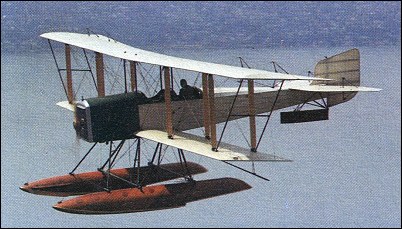|
| Worthy of brief mention as the very first of the long line of Boeing aircraft, the Model 1 was known also as the B & W. Its design was the result of a collaboration between William E. Boeing and a friend, Cdr G.C. Westervelt of the US Navy, and the B & W designation recognised this association. Of wood and fabric construction, extensively strutted and wire-braced, the Model 1 was an unequal-span biplane, with ailerons on the upper wings only. The fuselage, mounted directly on the lower wing, had two open cockpits in tandem, and carried at the rear a tail unit that was a typical braced structure of its period. Power was provided by a Hall-Scott engine mounted in the nose of the fuselage to drive a tractor propeller. Floatplane landing gear included two single-step floats, strut-mounted and braced beneath the fuselage, plus a small float under the tail to prevent disaster in a tail-down landing.
The first of two Model 1s was flown initially on 29 June 1916, by which time Cdr Westervelt had been posted to the other side of the American continent. William Boeing decided, therefore, to establish a company to build these aircraft, and his Pacific Aero Products Company was founded on 15 July 1916. The first company to incorporate the Boeing name, the Boeing Airplane Company, was formed on 26 April 1917. The two Model 1s, construction numbers 1 and 2,
were sold to the New Zealand government.
| ENGINE | 1 x 93kW Hall-Scott A-5 inline piston engine |
| WEIGHTS |
| Take-off weight | 1270 kg | 2800 lb |
| Empty weight | 953 kg | 2101 lb |
| DIMENSIONS |
| Wingspan | 15.85 m | 52 ft 0 in |
| Length | 9.5 m | 31 ft 2 in |
| Wing area | 53.88 m2 | 579.96 sq ft |
| PERFORMANCE |
| Max. speed | 121 km/h | 75 mph |
| Cruise speed | 108 km/h | 67 mph |
| Range | 515 km | 320 miles |
| the guy, 16.11.2009 01:22 planes reply | | Merv Shetler, e-mail, 03.07.2008 21:54 Bill Boeing named the first two airplanes after some ducks that lived on Lake Union where the airplanes were built. The Boeing Volunteer Retirees origanized 1995 have adopted the name of the first Model 1( a Bluebill) as their logo. We wanted to be the lead duck of volunteers in the Puget Sound area. The second airplane was called the Mallard reply |
|
Do you have any comments?
|
| 
COMPANY
PROFILE
All the World's Rotorcraft
|






